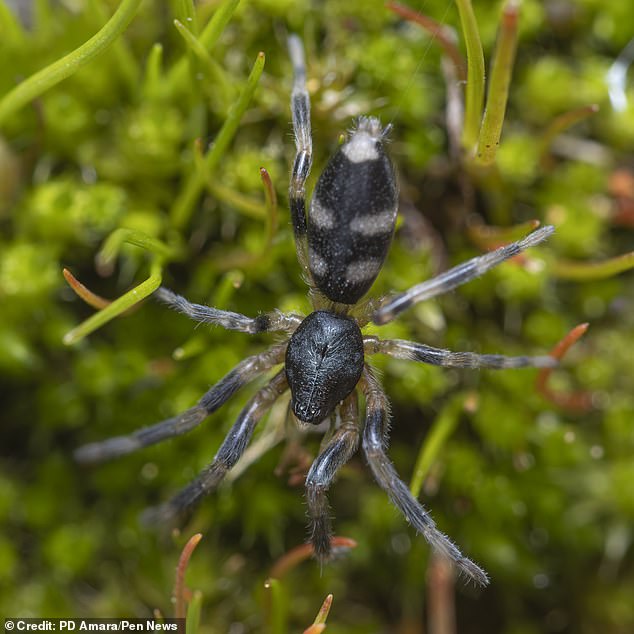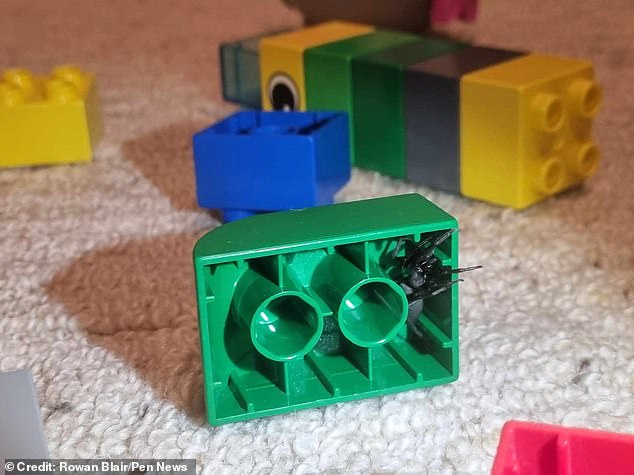Would YOU spot it? Venomous spider is discovered lurking in a toddler’s Duplo in terrifying playtime encounter
This is the terrifying moment a poisonous spider is discovered in a toddler’s Duplo during play.
Rowan Blair was at home in Melbourne, Australia, when a scream from another room prompted him to take action.
He said: ‘My wife had our 18-month-old daughter on her lap and had just thrown the large box of Duplo on the floor before she screamed in terror.
‘I ran into the room, my daughter had been placed on a large chair and was startled – probably more by my wife’s screaming than by the spider.
She said, “pider… dooon’t touch,” which is a variation on the mantra we use at home: “look, but don’t touch.”
This is the chilling moment a poisonous spider is discovered in a toddler’s Duplo while playing

Mr Blair believed it was a white-tailed spider, a venomous species whose bite can cause burning blisters and – occasionally – nausea, vomiting and headaches.
‘My wife had gone to get some tissues, and when she came back and I arrived, the spider was nowhere to be seen.
‘We had to turn each block over individually and put it back in the box until we found the piece where the spider was hiding.’
The 40-year-old Mr. Blair grabbed his camera and took some pictures of the intruder.
He believed it was a white-tailed spider, a venomous species whose bite can cause burning blisters and – occasionally – nausea, vomiting and headaches.
Their bites also have a reputation, and much criticized for, of causing necrosis – where skin tissue dies.
Rowan’s suspicions were confirmed when he shared a photo with a Facebook spider identification page.
He said, ‘My first instinct was that it was a Badumna or black house spider.
‘We have quite a few on the outside of the house, high up in the corners of the eaves, but I haven’t seen them inside yet.
‘It wasn’t until I looked more closely that I assumed it was actually a lampona, a white-tailed spider, because it has a much longer and more slender body.’
He added: ‘I would rather move the spider than kill it, but my wife quickly took action and crushed the spider before I had the chance.’

By sharing a photo to a Facebook page dedicated to identifying spiders, Rowan’s suspicions were confirmed

White-tailed spiders have a dark red to gray, cigar-shaped body and dark orange-brown banded legs
Although the Blairs are used to seeing spiders, this encounter with them still had an impact on them.
Rowan said: ‘Because the spider was quite large and had shocked my family, we were quite nervous about the spider over the last 24 hours.
‘We are going to thoroughly clean that part of the house: the children’s play area.
‘But my wife and I agreed that we live in Australia, there are spiders everywhere and nine times out of ten we will move them if we can.
“If we see them as a potential threat to our young children, then I have no problem removing the spider.”
According to the University of Melbourne’s School of Biomedical Sciences, the idea that white-tailed spider bites can cause skin ulcers and necrosis has been around for “decades”.
In a species profile, the university acknowledged a “small number of cases of significant tissue loss” resulting from observed bites from white-tailed spiders.
But it stressed that most alleged cases are “based at best on circumstantial evidence”.
Reference was also made to a 2003 study that found no necrotic ulcers in 130 patients with white-tailed spider bites.
